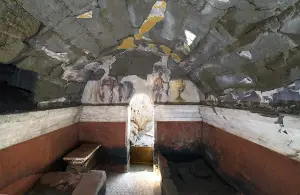|
2nd Century B.C. Tomb Wall Painting Restored
September 25, 2018
Archaeologists in Italy have restored a ancient painted burial chamber enough for public viewing. The chamber, found in the remains of the famous Greek settlement Cumae, dates to the 2nd Century B.C. Most of the painting on the walls has deteriorated over time. Among the things still visible on the walls are landscape scenes and a servant holding a jug and vase. Also surviving are a wooden table and a wine amphora. Because of the presence of those things and of other traces of funerary furnishings, archaeologists have concluded that the tomb was built for a wealthy person in the 2nd Century B.C. In this century, archaeologists from France have found a large number of sepulchers, including several vaulted burial chambers. The recently revealed tomb was found in June 2018 and was the first tomb found that wasn't painted in solely red or white. Greek settlers from Euboea founded Cumae in the 8th Century B.C. The settlement flourished as a Greek entity but was taken over by Rome in the 4th Century B.C. Several early Roman legends tell of the famous Cumaean Sibyl, a priestess at the Apollonian oracle who has been preserved in several famous Renaissance artworks, including at the Sistine Chapel and in a fresco by Raphael. The city was nearly destroyed in the Middle Ages; its remains now rest in the Campi Flegrei archaeological park, near the modern village of Cuma, in Campania, a couple of dozen miles away from Naples. |
Social Studies for Kids |
Social Studies for Kids
copyright 2002–2019
David White





